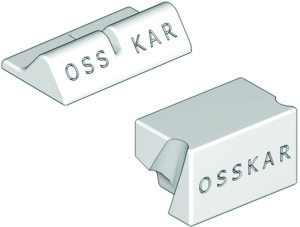OSSKAR – A positioning device for hands-free stress imaging of the knee

Placing a patient’s knee in a ‘stress’ position while taking an x-ray enables full cartilage visualisation, a prerequisite for determining their suitability for total vs. partial knee replacement. As the latter is associated with both improved patient outcomes and health economics, stress knee radiographs are of high value in clinical decision making.
At present, stress positioning is carried out using complex medical devices that are heavy, expensive and unpleasant for the patient. Alternatively, the lower limbs can be manually held in place, which is not only expensive but involves the clinician experiencing radiation exposure. Due to these limitations, stress-positioning radiography is often not carried out and patients are inappropriately referred for total knee replacement.
OSSKAR (the Oxford Stress System for Knee Arthroplasty Radiographs) is a new approach to stress positioning, providing a simple and light-weight medical device for comfortably placing patients in standardised stress positions for x-ray radiography while removing the need for a clinician.
OSSKAR is CE-marked and currently undergoing clinical trials.
Partial or total knee replacement?
Unicompartmental knee replacement (UKR) has significant clinical benefits over total knee replacement (TKR), such as half the risk of venous thromboembolism, myocardial infarction or deep infection, two thirds the risk of stroke, one quarter the risk of blood transfusion and significantly lower mortality up to eight years following their operation. However, despite being appropriate in half of patients, UKR is carried out in only 8% of cases, with large variation between centres. The main reasons for this poor adoption rate is the difficulty in identifying which patients demonstrate appropriate pathology for this procedure, such as bone-on-bone arthritis in the medial but not lateral compartment.
The need for an informed decision
While a variety of approaches are available to investigate knee pathology, such as MRI or arthroscopy, X-ray radiography of the joint while placed in a series of standardised stress positions remains the gold standard. However, this requires either complex medical devices or the presence of a clinician. These approaches are either uncomfortable for the patient or place a costly demand on a clinician’s time while exposing them to harmful x-rays (approx. 300 times a year).
Reducing the stress – a patient and practitioner-friendly device
Researchers from the University of Oxford have developed OSSKAR, a simple hands-free device that could greatly facilitate knee stress radiography and consequently ensure all patients receive the most appropriate and cost-effective knee replacement surgery.
Key benefits
- Simple, lightweight and inexpensive to manufacture
- CE-marked
- Allows both legs to undergo stress simultaneously
- Causes minimal patient discomfort
- Removes need for costly and invasive MRI or arthroscopy
- Removes need for manual positioning and therefore clinician radiation exposure
- Potential for horizontal beam lateral x-ray and ligament insufficiency assessment
about this technology

